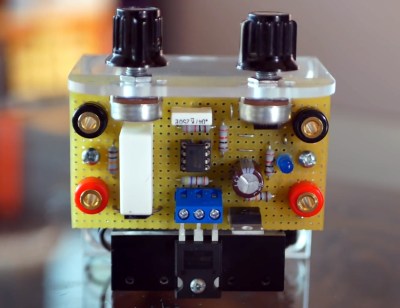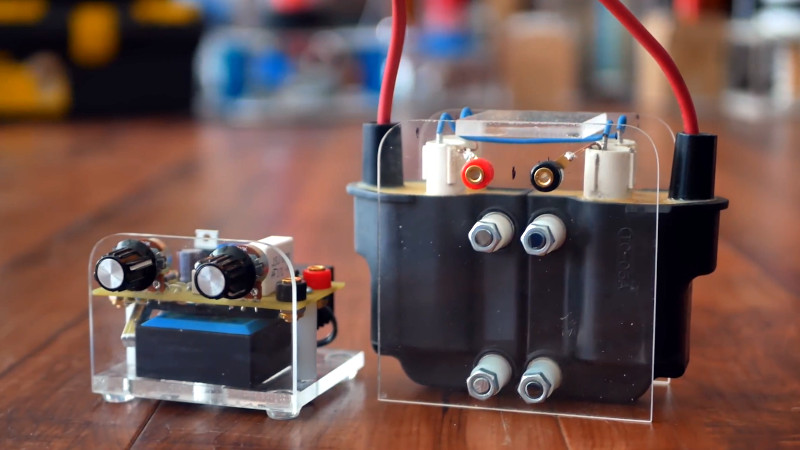High-voltage experimenters have been using automotive ignition coils to generate impressive sparks in the home lab for decades, and why not? They’re cheap, easily obtainable, and at the end of the day, producing sparks is literally what they’re designed to do. But that doesn’t mean there isn’t room for improvement.
In his latest Plasma Channel video [Jay Bowles] revisits this classic experiment, bringing to bear the considerable high-voltage experience he’s gained over the last several years. Building on an earlier setup that used a single Honda ignition coil, this new dual-coil version can produce up to 60,000 volts and is driven by a cleaner and more reliable circuit based on the iconic 555 timer. A pair of potentiometers on the front of the driver can adjust its square wave output from 1 to 10 kilohertz manually, while a commercial Bluetooth audio receiver tied into the 555 circuit allows the output to be modulated by simply playing audio from a paired device.
 As [Jay] explains, wiring up a basic ignition coil is very simple. Usually there are just three terminals: the positive and negative inputs, and a high-voltage output. But in this case since he’s driving two coils, he’s actually wired one backwards. Bolted into a nice acrylic holder and with banana plugs to provide the roughly 18 – 25 VDC input, you’ve got a compact and reliable high-voltage source. The driver itself is an evolved version of a circuit he’s used in past projects, and beyond the addition of the Bluetooth audio input, now features a snubber circuit to help keep the 555 from getting cooked.
As [Jay] explains, wiring up a basic ignition coil is very simple. Usually there are just three terminals: the positive and negative inputs, and a high-voltage output. But in this case since he’s driving two coils, he’s actually wired one backwards. Bolted into a nice acrylic holder and with banana plugs to provide the roughly 18 – 25 VDC input, you’ve got a compact and reliable high-voltage source. The driver itself is an evolved version of a circuit he’s used in past projects, and beyond the addition of the Bluetooth audio input, now features a snubber circuit to help keep the 555 from getting cooked.
So what’s the result? Well a lot of gorgeous sparks, for one thing. But with audio playing through Bluetooth, the arc between the dual coils will act as a plasma speaker. The output is clear, but not terribly loud. According to [Jay] that’s because the ignition coils weren’t meant to be driven at such high frequencies, with the result being reduced output voltage. But as demonstrated at the end of the video, it turns out there’s more than one way to get audio out of this rig; with an antenna connected to the output of the coils, the system becomes a radio transmitter.
In the market for more high-voltage fun using the 555? Check out this DIY plasma ball driven by the fifty year old integrated circuit that hardware hackers just can’t get enough of.
















Awesome. I will be building my next speakerphone shortly.
Ford Model-T ignition coils were my introduction to electricity. I bought one in 1953 and it didn’t take long to figure out how to get sparks to come out. It was packaged in a wooden box, beautifully constructed with box joints, and had an electromechanical vibrator at one end. Junk yards had lots of them and some would give them to a kid for free, if he brought his own tools and removed them. They made noise, but they did not sing.
If you have never seen one, take a peek.
https://www.youtube.com/watch?v=trawLrGOlMA
When I was a kid about 20 years later, around 1973, all the books on electronic projects suggested motel T coils, but by this time they weren’t easily available to a kid. I suspect an auto restorer can still buy them today, but even in ’73 you couldn’t find them cheap or free. I took a set of points and condenser from a Briggs and Straton lawn mower engine, a piece of steel packing strap and an electromagnet to make an interrupter and connected it in series with a spare coil for our 1966 Oldsmobile. Nice big sparks!
Awesome presentation, really like Jay’s videos. Seems like kind of guy that would be fun to hang out with. Rare for modern “YouTubers”.
Sooo… I can use one of these as a replacement for a bad high voltage generator on a vector monitor?
(I have a customer whose Atari Asteroids died 10 minutes after he recapped the monitor – I only fixed the circuit board)
I know they don’t like high frequencies. Driving them at low frequencies MIGHT cause visible artifacts. But… maybe… two of them with an alternating square wave?
“Please be kind and respectful to help make the comments section excellent. (Comment Policy)”
Your reply is neither kind nor respectful. It is not helpful or interesting either.
One of these days he’s either going to receive a letter or a knock on his door from the FCC. Spark gap transmitters were outlawed back not long after the Titanic was sunk, for a reason.